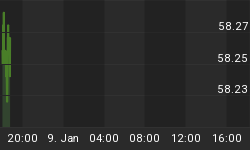Below is an excerpt from a recent commentary posted at www.speculative-investor.com. Excerpts from our newsletters and other comments on the markets can be read at our blog: http://tsi-blog.com/
We suspect that the gold bull market that began in 2001 is, in very rough terms, an elongated version of the 1971-1980 bull market. Part of our reasoning is that there is evidence in the performance of the gold-mining sector of a bullish gold trend beginning in the early-1960s, with gold itself being unable to reflect this bullish trend until 1971 when it was officially untethered from the US$.
At the point when the official link to the US$ was broken, the gold price was like a coiled spring. After it was released it shot upward in spectacular fashion to a high in 1974 and then plummeted to a low in 1976, all as part of trying to find the level that best reflected gold's value under the new monetary system.
Our point is that due to gold's price being fixed at $35/oz until 1971, what would have been an 18-20 year bull market ended up being compressed into 9 years.
This time around the gold price has been free to fluctuate in response to changing economic and financial-market conditions. As a result, the rise to the 2011 top was much longer and steadier than any of the cyclical advances of the previous secular bull market and the decline from the 2011 top has also been longer and steadier than the single cyclical decline of the previous secular bull market.
A consequence of the gold price being fixed at $35/oz during what was, we think, roughly the first half of the previous secular gold bull market is that it's not possible to say something along the lines of "we are now at the equivalent of point X from the previous bull market". For example, although using the following weekly gold chart to make a superficial comparison of the two bull markets could lead to the conclusion that the current bull market is near the equivalent of the previous bull market's point B, we need to take into account that the pattern of the 1970s partly results from the elimination of the advance that would have taken place from the early to the late 60s if the gold price hadn't been fixed. This 'missing' advance of the 1960s in the bullion market is clearly evident on the chart of the Barrons Gold Mining Index (BGMI) displayed below the gold chart.


So, whereas a superficial view of the US$ gold price action could lead to the conclusion that the present is the equivalent of somewhere in the 1976-1977 range, an argument could be made that the present is actually more like the early-1970s. Although the gold price chart doesn't show it, the early-1970s was really when the first cyclical decline of the earlier long-term gold bull market came to an end. In addition, the position of the broad US stock market today certainly has a lot more in common with 1972 than 1976-1977.
The fixing of the gold price during the 1960s also makes it difficult to directly compare the secular bear market of the S&P500 relative to gold that extended from the late-1960s to the early-1980s with the secular bear market that began during 1999-2001. The reason is that if the gold price had been free to fluctuate, the SPX/gold ratio most likely would have been in a downward trend during the 1960s instead of having the slight upward bias shown on the following chart.
At a superficial level the SPX/gold ratio's performance over the past few years looks most similar to its performance during 1975-1976, but, again, this is largely a result of gold's price being fixed prior to 1971.

The prevention of an upward trend in the gold price during the 1960s and the subsequent compression of a secular bull market into the space of only 9 years gets in the way of direct chart-based comparisons between the current secular gold bull market and the preceding one. That partly explains why such comparisons have been unreliable, although it should always be kept in mind that there are going to be significant differences between the current cycle and any previous cycle.
Samples of our work (excerpts from our regular commentaries) and additional thoughts on the financial markets (and other stuff) are provided at our blog: http://tsi-blog.com/















